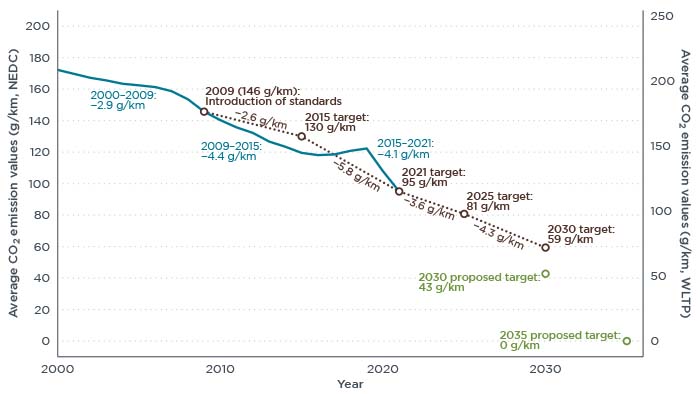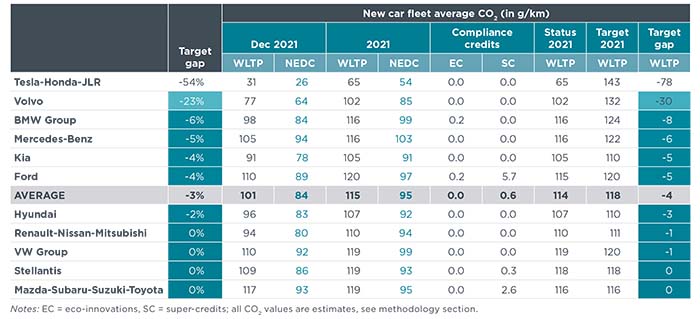Blog
Germany, not the land of compact cars: Why the EU new car CO2 standards are nothing to fear
When the European Commission proposed the first set of mandatory CO2 standards for new passenger cars, the outcry was loud—especially in Germany where cars are typically regarded as a sacred status symbol. “We cannot allow Brussels to turn Germany into a country of compact car drivers!” Erwin Huber, Bavarian Minister of State for Economics, Transport and Technology grumbled back in 2007, suggesting that the proposed average CO2 target of 130 g/km by 2015 could not be met while preserving the diversity of vehicle types on the market. Today we know, of course, that manufacturers met this target with flying colors, and some even several years in advance.
The same spectacle repeated itself during the negotiations around the next stage of the regulation, which set a new car CO2 target of 95 g/km for 2021. Again, lobbyists for the car industry warned that the target would be overly difficult and expensive to achieve. And again, their scaremongering turned out to be wrong. Manufacturers were able to ensure compliance and avoid any fines, even while the market share of SUVs increased year after year.
The official data from the European Environmental Agency (EEA) will not be available before mid-2022, but our ICCT Market Monitor data indicates that all major car manufacturers met their respective new car CO2 targets for 2021. On average, in terms of the New European Driving Cycle (NEDC), the 2021 market was at about 95 g/km of CO2. Converted to the new Worldwide Harmonized Light Vehicles Test Procedure (WLTP), the market average was around 114 g/km compared to an average target of around 118 g/km. Throughout the years 2020 and 2021, manufacturers, on average, decreased their new car CO2 levels by more than 1 g/km per month. The average reduction rate for the years 2009 to 2021 was just about 4 g/km per year, illustrating the particular efforts manufacturers put forward with actual target values imposed, rather than in the interim years in which the target values did not see any further tightening.

Average CO2 values and fleet targets
Pooling turned out to be a particularly important instrument for compliance. FCA formed a pool together with Tesla in 2020, thus securing a pool fleet average CO2 value low enough to avoid any regulatory fines. In 2021, FCA took shelter under the Stellantis pool umbrella, together with Peugeot and others, again making up for its own relative high CO2 levels. Meanwhile, Tesla went on offering its help for complying with the CO2 regulation and for 2021 formed a pool with Honda and JRL. Other key pools included the Ford-Volvo pool in 2020 and the Mazda-Subaru-Suzuki-Toyota pool in 2021.
Aside from pooling, electrification, of course, was key for meeting the 2021 fleet CO2 targets. The average sales share of battery-electric passenger cars reached 10% in 2021, up from 2% in 2019 and 6% in 2020. In addition, plug-in hybrid cars accounted for 9% in 2021, up from 1% in 2019 and 5% in 2020. The compliance effect of electrification was amplified by the super credits multiplier, on average amounting to 6.6 g/km in 2020 and 0.6 g/km in 2021.
The impact of eco-innovation credits and changes in the average new car fleet mass on CO2 target compliance remains unclear until the official EEA statistics are published. These two factors are not taken into account in our ICCT Market Monitor and likely result in us under-estimating manufacturers’ performance, i.e. in reality, manufacturers will likely outperformed their targets by a greater margin than we estimate. This expectation is supported by public statements, such as from VW Group which announced having over-achieved its 2021 CO2 target by 6 g/km, whereas in our Market Monitor estimates over-achievement on the order of 1 g/km.

New passenger car fleet average CO2 emission level by manufacturer pool.
In order to be in line with EU climate protection targets for 2050, we need to phase out new combustion engine cars by 2030 or at the latest by 2035. Vehicle manufacturers themselves are already heading in this direction, with public phase-out announcements adding up to a new car market share of about 50% purely battery-electric vehicles by 2030 at this point. With its proposal to set a -100% CO2 target for new cars for 2035, the European Commission is taking a stand in turning these ambitions into actionable regulatory targets.
The EU CO2 standards are not perfect: the lack of interim targets resulted in fluctuating emission levels; the lack of an enforceable real-world metric resulted in a growing gap between official and real-world values; and the focus of vehicle mass as a benchmark parameter allowed an unprecedented uptake of SUVs. But, ultimately, the EU CO2 regulation for new cars proved to be an effective policy instrument, driving technology innovation while maintaining the traditional market structure and single-handedly turning the EU into a global leader for electric vehicle uptake.
In 2022, we will witness what may well be the last round of the CO2 regulation as we know it. It is now in the hands of the European Parliament and EU Member States to debate and ultimately confirm the proposal of the European Commission for defining an end date for new combustion engine cars that is in line with the EU’s climate protection targets. And again, there are lobbyists warning about the unattainability of CO2 standards and combustion engine phase-outs. But as history has shown, with clear targets in place, manufacturers can adapt, and regulators should take this latest scaremongering with a pinch of salt.
